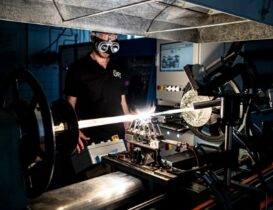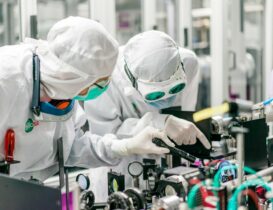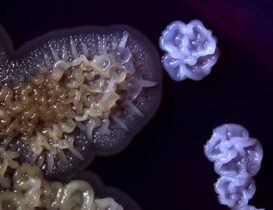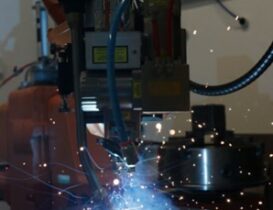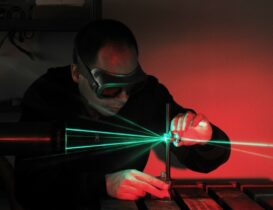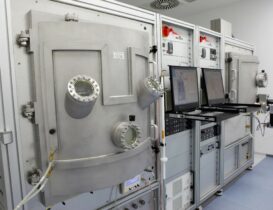The LasApp project aims to effectively support lasers and thus also the technological development of the Czech Republic. It will connect excellent research centres of the Czech Academy of Sciences, Charles University and other institutions, and will focus on the most advanced fibre and thin-disc lasers, which are used in engineering, medicine and defence systems. The project, co-funded by the European Union, has received support from the Jan Amos Komenský Operational Programme (OP JAK) of the Ministry of Education, Youth and Sports in the Top Research Call.
The invention of fibre and thin-disk lasers is changing the world of laser applications. The ambition of LasApp: Breakthrough Laser Technologies for Smart Manufacturing, Space and Biotechnology Applications, is to give the Czech Republic a technological edge. Fibre and thin-disc lasers are largely complementary. While fibre lasers have the advantage of high average power, and are currently the most powerful lasers ever, being highly popular especially in engineering due to their low maintenance, thin-disc lasers dominate wherever high-energy pulses are needed, e.g. in laser resurfacing for material refinement in the energy sector or aerospace.
Precisely fine and coarse fibre lasers
As far as fibre lasers are concerned, the Institute of Photonics and Electronics of the CAS (IPE CAS), which coordinates the entire project, has been considered a national centre of scientific competence for over thirty years. The high energy efficiency of fibre lasers and the quality of the output beam of radiation open up new horizons in many fields: from delicate eye or kidney stone surgery in medicine, through brute force cutting and welding in industry, to space research and defence systems.
In addition, the Fiber Lasers team of the Institute of Fiber Lasers of the CAS is developing a unique technological infrastructure for the preparation of active fibres. „The original method of preparation of fibres by nanoparticle doping developed at the Institute of Chemical Engineering of the CAS has proven its worth in the European Defence Agency project for the development of a new generation laser-based drone defence system. However, the potential of these lasers is more than an order of magnitude higher than current records and we will not reach the theoretical limits without finding breakthrough technological solutions,” says project coordinator Pavel Peterka from the Institute of Photonics and Electronics of the CAS.
“Instead of the current 200-300 watt laser systems at the eye-safe wavelength of around 2 micrometres (µm), we could achieve lasers with an output power of several kilowatts (kW). By combining these, it is then possible to create, for example, defensive anti-drone laser systems that can also be used to protect critical infrastructures in urban environments. The risk of eye damage from reflected light is up to three orders of magnitude higher with current defence lasers at a wavelength of around 1 µm,” adds Pavel Peterka.
Collaborative scientific excellence
The LasApp project primarily develops existing state-of-the-art laser technologies, in the research of which the Czech Republic belongs to the world leaders, and seeks completely new directions of application, which have the potential to provide breakthrough solutions on an international scale. It involves six partners. In addition to the Institute of Photonics and Electronics of the CAS in Prague, the project includes the HiLASE Laser Centre in Dolní Břežany (Institute of Physics of the CAS), the Faculty of Science of Charles University (BIOCEV centre in Vestec), the Institute of Instrumentation Technology of the CAS in Brno, the Institute for Nanomaterials, Advanced Technologies and Innovations of the Technical University of Liberec and the Institute of Plasma Physics of the CAS (TOPTEC centre in Turnov).
Records and practical use
Scientists at the HiLASE Laser Center are building on previous breakthrough results with the Bivoj laser, which uses cryogenically cooled slab amplifiers. “The Bivoj laser regularly generates 145 joules (J) of energy in a pulse lasting 10 nanoseconds (ns) at a repetition rate of 10 hertz (Hz) and a wavelength of 1030 nanometers (nm). This not only still represents a world record, but also provides a great tool for advanced applications,” says Tomas Mocek, Head of the HiLASE Centre at the Institute of Physics of the CAS. “In addition, we are extending the PERLA picosecond thin-disk laser platform to the spectral region around 2 µm, which will allow us to implement selected space applications in the LasApp project. As usual, we are aiming high,” adds Tomáš Mocek.
“Our team focuses on the innovative use of laser technology in biomedicine and biotechnology, with an emphasis on microbial biofilm research. Biofilms, complex communities of microorganisms, are significant contaminants in many industries and are a serious source of infections. Identifying such laser-treated surfaces that effectively suppress biofilm formation is our primary goal. Research into the basic principles of biofilm formation and a better understanding of the dynamics of biofilm development is also a key prerequisite for success,” said Zdena Palková from the Faculty of Science of Charles University at the BIOCEV Centre (Biotechnology and Biomedical Centre of the CAS and UK) in Vestec.
“I believe that our expertise in the use of sensors, signal processing, data-driven optimization or machine learning and AI will significantly contribute to the ambitious goals of our joint project,” says Jan Kočí, head of the Systems Integration research area at the Institute for Nanomaterials, Advanced Technologies and Innovations at TUL.
“We are preparing a new, own version of hybrid Laser – MIG welding at ÚPT. This is electric arc welding in a protective atmosphere, which is proving promising for welding of refining materials and potentially for 3D printing of metals. Initial experiments show that this technology, in addition to increasing speed and therefore efficiency, can offer other technological and economic benefits,” says Libor Mrňa, Head of the Laser Technology Group, Department of Coherent Optics, Institute of Scientific Instruments of the CAS.
More than 60 years of cutting-edge laser tradition
Broad collaboration with other institutes in the Czech Republic, including CTU, will be important, as the LasApp project has the ambition to create a distributed infrastructure that would cover and coordinate research and development in the field of cutting-edge laser technologies, both in the research of advanced laser radiation sources and their potential use for smart processing and refinement of materials for circular economy, space and biomedical applications. The efficiency of current infrastructure investments will thus build on previous periods.
“The LasApp project includes workplaces that assembled and commissioned the first Czechoslovak lasers in 1962-1963 and are now among the leading workplaces in the field of laser technology in the Czech Republic and internationally. At ÚFE we focus on research of special optical fibres for fibre lasers, especially new types of active fibres, fibres with air holes for gas lasers and for transmission of high-power radiation. We will look at their use in new types of fibre lasers and other applications,” said project coordinator Pavel Peterka from ÚFE. The LasApp project is a follow-up to the AV21 Strategy’s Light in the Service of Society programme completed last year, which was coordinated by the HiLASE Centre and the ÚFE team was responsible for public safety and critical infrastructure issues.
Don’t compete, cooperate. With EU support
The LasApp project succeeded in the competition of 66 projects submitted to the Top Research call in OP JAK. This call is aimed at supporting research with the potential for excellent results applicable in practice. In total, 26 projects worth 12.2 billion CZK were supported. The multiannual OP JAK is managed by the Ministry of Education, Youth and Sports. In the 2021-2027 programming period, OP JAK receives funding from the European Structural and Investment Funds (ESIF). This amounts to 90 billion CZK, of which 43 billion is intended to support research and development, 19 billion to support universities and 28 billion for regional education. The funds are dedicated to excellent research teams that will help Czech scientific institutions deepen their relations with foreign partners, while at the same time, providing a new tool of sorts to replace competition with cooperation. An important goal of the challenge is to overcome the fragmentation of the Czech research environment.


